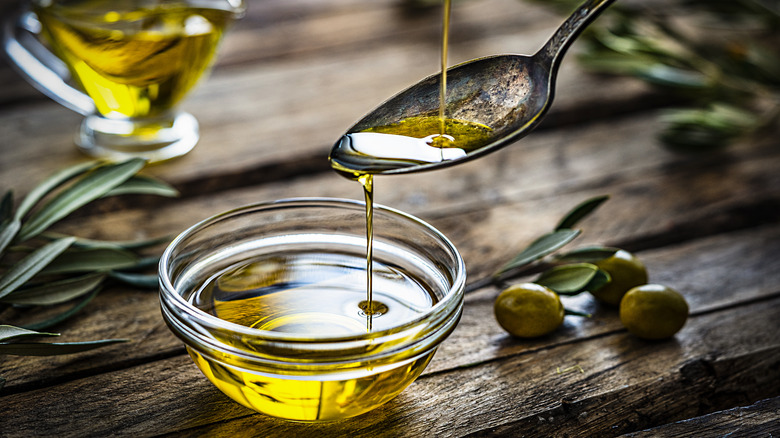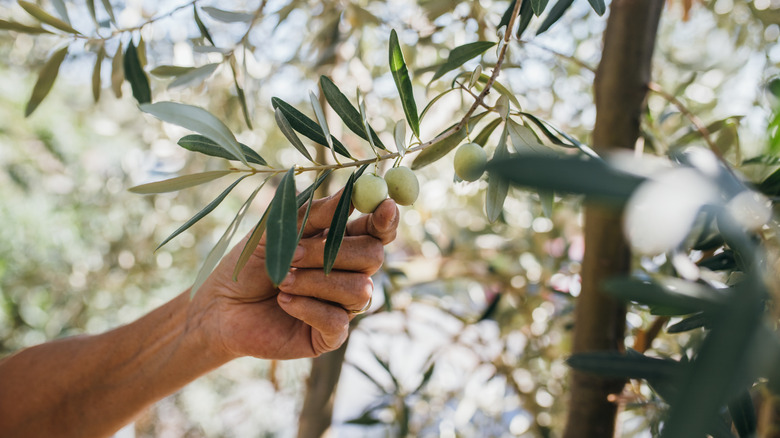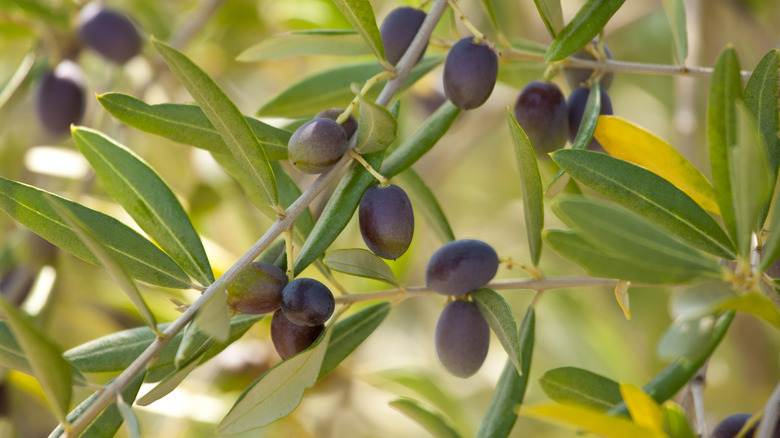Why Green Olives Are Preferred For Making Olive Oil
Olive oil is a staple in most modern kitchens. It's one of the most versatile cooking oils, so its popularity makes sense. Use it to saute some sliced zucchini in a pan or drizzle it on top of some leafy greens for a simple salad dressing, and that's just a tiny taste of the endless possibilities.
There are just as many varieties of olive oil as there are ways to use it, and every bottle is different. An oil can be extra-virgin or refined, higher or lower in acidity, or even come in different packaging that affects its taste. One of the most important characteristics of olive oil is what kind of olives were used to make it.
Any type of fresh olive (no, not the canned varieties) can be crushed and blended to create this beloved liquid fat, but some of the absolute best olive oils come from green olives. Green olives are harvested much earlier on in the growing cycle than any of the other olive varieties, and they are often preferred for making olive oil because they produce a much stronger flavor. Olive oil made from these fruits will taste much more pungent and peppery than other bottles, have higher levels of antioxidants and Vitamin E, and produce a distinctly fruity scent. This makes green olive oil perfect to use with milder dishes where its strong flavors can shine.
How to find olive oil made from green olives
Many olive oil producers opt for green olives over black, but from a consumer standpoint, it can actually be hard to determine exactly what type of olives are inside most bottles of olive oil. Many mass-produced bottles don't specify what type of olives they were made with. This usually means the oil comes from a blend of different olives. This isn't necessarily a bad thing, as every olive variety lends its own flavors and mouthfeel.
If you are curious about the specific taste of olive oil made with pure green olives, try buying olive oil that comes with an ingredient list. Don't buy olive oil purely based on its color, as this doesn't help determine the quality. Still, oils made with pure green olives can appear much greener in color due to their high chlorophyll content, so it can be a good indicator of an oil's makeup if you don't have much other information to work with.
What other olive varieties have to offer
All olives start out green, then gradually darken as they ripen until they become black. So, the different colors of olives simply indicate that the fruit was harvested in different stages of its growing process. Black olives (and all those other more ripe varieties) may not yield as strong of a flavor in olive oil as green, but they do tend to produce more oil than green varieties can, which makes them easier to use in the olive oil production process. Oils made from these riper varieties will also have a much smoother, more buttery flavor than green olive oils, so they are a well-rounded addition to almost any recipe.
At the end of the day, harvesters will choose to use different olives depending on the intended flavor profile. There are a lot of other olive oil characteristics that are important in determining its quality, such as where exactly those fruits are sourced from. The design of the bottle is also important, as glass bottles will expose the oil to light, which degrades it much faster than darker packaging materials; that's why olive oil bottles are often green. So, if you're in the market for a new olive oil, keep all these factors in mind to make the best choice for you and your kitchen.


